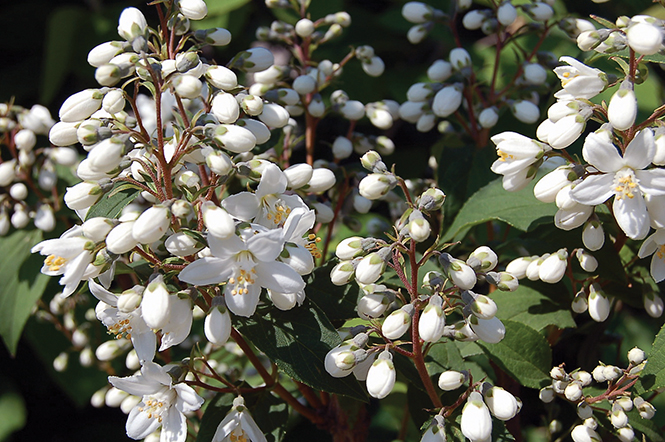Spring Sensation

This new but old-fashioned deutzia has masses of showy, white flowers
I have always been a fan of what today are considered old-fashioned plants. Deutzia (pronounced du-t-ze-a) is certainly one of them, but as with many old-fashioned things, sometimes they make a comeback and become fashionable once again.
Spring Sensation Deutzia is beautiful and generally always prompts the question, “What is that?” While most deutzia have a natural arching habit, Deutzia x hybrid ‘Kolmaspri,’ Spring Sensation, shown at right, is very upright. Its strong stems are covered from top to bottom in small white flowers in mid to late spring. The flowers are lightly fragrant, and once fully open remain on the plant for up to six days.
Leaves are medium green, simple, and slightly hairy. Certainly not unattractive when not in flower, but it has a slightly unkempt appearance and is just an average green plant or shrub for most of the growing season. Plant in full sun but it is also tolerant of part shade. Deutzia are known to do well in clay soils and are quite drought-tolerant once established.
Said to grow 3 to 4 feet tall and 2 to 3 feet wide; however, Spring Sensation deutzia is quite new in cultivation. Environment and more growing time will reveal its true nature. If a smaller plant suits your garden, Deutzia gracillis ‘Nikko’ is an excellent choice. This small deutzia grows only 2 feet tall and has a nice low-arching habit. It is very beautiful when planted on a slight slope or around large, smooth rocks in the garden.
Pick one or both of these for your garden and you will be rewarded with a beautiful spring white flower show. Old-fashioned or not, either cultivar makes an excellent addition to any Kentucky garden.
SHELLY NOLD is a horticulturist and owner of The Plant Kingdom. Send stories and ideas to her at The Plant Kingdom, 4101 Westport Road, Louisville, KY 40207.
ASK THE GARDNER
Angie McManus
Q I have white fuzz on the buds of my orange lilies. Can you tell me what I can use to clean them?
A White fuzz, as you have described, is an indication that aphids are on your lilies. Aphids are insects that pierce and suck plant juices. They are usually found on buds and new growth. As they feed, they secrete a sticky substance known as honeydew and as a result, black sooty mold develops. This all sounds discouraging but as long as you keep the population in check, the potential of disease spread is decreased.
You can take a damp cloth and wipe the buds; the aphids will come off easily. If any of the foliage is curling and/or yellow, you should take a close look to see if there is any insect activity. You can prune off all parts of the plant that look bad. Insecticidal soap and Neem oil products are effective, organic control options.
For more information about aphids and controlling them, go online to the University of Kentucky College of Agriculture, Food and Environment at www.ca.uky.edu and type “ENTFact-103” or “ENTFact-406” in the search box to read or download two excellent publications by Extension entomologist Lee Townsend.
Have a gardening question? Go to www.KentuckyLiving.com, click on Home & Garden, then “Ask The Gardener.”

